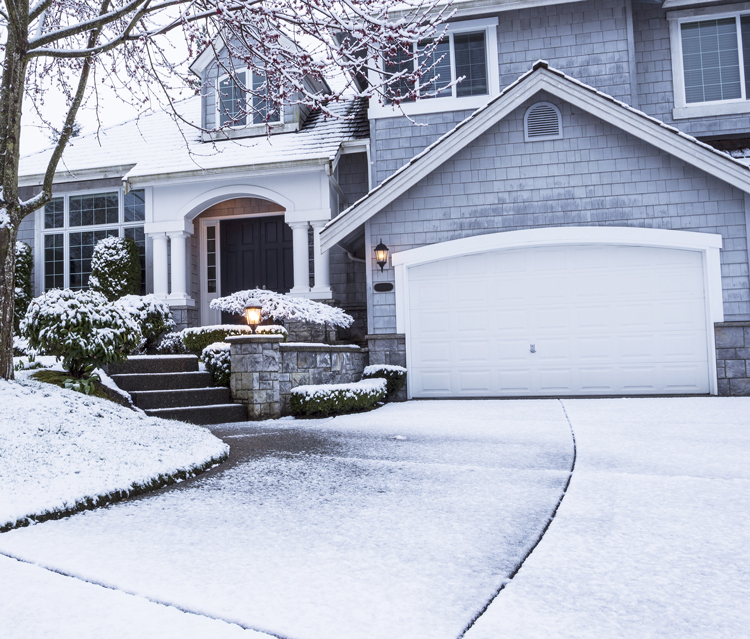
As the days get shorter, thoughts of winterizing your home and landscape should take priority.
If you don’t have sufficient time right now, keep an eye on the weather and at least make a visual inspection. This could save valuable time recovering from an unexpected hard freeze.
As Oklahoma natives know all too well, weather conditions can quickly change around here.
Your top priority is being aware of the current state of your outdoor environment. Make note of necessary tasks and prioritize them as time and weather conditions permit.
In order of importance, here are the three landscape winterization steps that will protect your home and its surrounding landscape.
Step #1 – Inspect and Tidy Up
Inspection is the best prevention because once we get the first hard freeze, there may be unrecoverable damage.
Walk your property without any distractions. You may notice small problems that can be remedied before they grow larger. Make a list of anything that catches your attention. This could later provide clues to hidden problems that had previously gone unnoticed.
If you have planters outside, now may be the time to empty them before their contents are frozen solid. If that’s not easily done, consider pulling them into the garage or shed where they are less likely to freeze before you can get to them.
Basic tasks to complete before the weather turns
- Clear leaves and broken branches from your lawn.
- Disconnect hoses from their water sources
- Store outdoor furniture or protect them with coverings.
- Mow the lawn one last time while making a final property inspection.
You’ve now completed the most important step. What follows will require more time and labor, and possibly the help of an experienced landscape crew.
Step #2 – Protect Your Home & Hardscapes

Trapped water expands when it freezes. This cracks pipes and connectors and damages anything associated with them, such as water feature pumps.
Outdoor Spigots – It’s always best to shut off the water source within the home whenever possible. If you cannot do this, you need to remove hoses and other connectors to provide room for water to expand. This includes garden hoses attached to outdoor spigots.
Water Features – Disconnect the feature from its water source and drain it. Pumps should be disconnected and stored in a warm, dry environment.
Irrigation Systems – If your irrigation system is not self-draining, it’s vital to hire a professional irrigation company to winterize it. This involves using a compressor to blow all the water out of the lines and removing the backflow preventer to safely store it where it’s protected from freezing.
As a precautionary measure, the same procedures are sometimes taken to protect self-draining systems.
Landscape Lighting Systems – Autumn and winter rains and snow can greatly test your landscape lighting’s functionality. The most common sources of problems are cable connections. Now is the time to make necessary repairs while the soils are still workable.
Outdoor Kitchens – Many Oklahoma homeowners use their outdoor kitchens year-round. However, they often take the precaution of turning off its water source and draining the lines before winter.
Gutters – Clean leaves and other debris to be sure water flows. If necessary, test the water flow with a garden hose before temperatures drop below freezing to be sure it’s clear.
Underground Drainage Systems – If you have an underground PVC drainage system, you will also want to check that it is draining properly. If above-ground corrugated drain tiles are attached to it, inspect them for any drainage bottlenecks. The objective is to be sure water is draining away from the home’s foundation.
Downspouts – If you have corrugated drain tiling attached to your downspouts, be sure to follow this same procedure so that water drains away from the home.
Surface Water – If you have sunken areas new your home’s foundation, it is best to bring in soil to ensure proper drainage away from the home. Settling over the winter will make springtime turf repairs that much easier.
Step #3 – Protect Your Plants
Well-hydrated plants are sufficiently protected from the harshest winters.
Plant root systems are protected when they are sufficiently hydrated. Even if they become frozen, most of them will recover because they are locked into a protected block of ice at 32 degrees Fahrenheit. However, roots in loose, dry soils will dry out and burn if air temperatures dip below the freezing mark.
Evergreens – Give special attention to watering evergreen trees and shrubs because their foliage is active throughout the winter. Deciduous trees and shrubs have already set tender buds for springtime. Those buds need moisture too, so give them equal care.
Slopes – All plantings on slopes are especially susceptible to drying. Take the extra time to ensure they are well-watered.
Animals and Frost – It’s advisable to wrap the tree trunks of young deciduous and ornamental trees with paper or burlap tree wrapping to protect against sunscald that leads to frost cracking.
If you do not have fencing protection, an additional measure of flexible corrugated drain tile wrapping should be applied to tree trunks to prevent deer and rabbit damage.
Consider Hiring or Consulting with Professionals
Some of the winterization practices discussed in this post will require professional assistance. We are happy to offer any assistance that you may need.
At Proactive Landscaping, we always try to deliver more than is expected. Check out the testimonials at the bottom of our home page to see what clients have to say in their words.
We would love the opportunity to help you keep your property safe and secure this winter. You can reach out to us by completing this inquiry form or by giving us a call at 918-808-8418.

